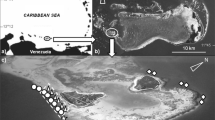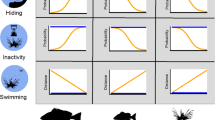Abstract
The invasion of Indo-Pacific lionfish on Caribbean reefs has prompted resource-demanding removals. Ecological tools to optimise the outcome of these costly efforts are scarce. Topographic complexity usually correlates strongly with fish abundance and can be mapped over large spatial scales. Determining the nature and strength of its relationship with lionfish abundance is therefore an important step in generating spatial prioritisation tools for removal programmes. Here, we quantify the relationships of lionfish density and hunting behaviour with topographic complexity, grouper biomass, and prey availability on the north-east reefs of Little Cayman. Lionfish density varied across sites irrespective of topographic complexity or density of prey fish, but was highest on the most rugose section of the reef terraces. Increased topographic complexity along the edge of the drop-offs caused modest increases in lionfish density. Grouper biomass caused no clear reduction in mean lionfish density, but narrowed the variance. Lionfish invested more time hunting on rugose sites with a paucity of prey refugia, implying that these may be places where prey fish are most vulnerable to predation. Under the reasonable assumption that lionfish display strong site fidelity, targeted removals are likely to yield the highest conservation benefits if focused on most rugose sites and at the edges of drop-offs. Determining whether longer hunting times yield increased predation rates, and quantifying the effectiveness of physical refugia in protecting prey from lionfish predation strikes, are important future research directions. If topographic complexity determines lionfish hunting success, there is a scope for mapping the vulnerability of prey, thus optimising practises aimed at managing the invasion.






Similar content being viewed by others
References
Albins M, Hixon M (2008) Invasive Indo-Pacific lionfish Pterois volitans reduce recruitment of Atlantic coral-reef fishes. Mar Ecol Prog Ser 367:233–238
Albins M, Hixon M (2011) Worst case scenario: potential long-term effects of invasive predatory lionfish (Pterois volitans) on Atlantic and Caribbean coral-reef communities. Environ Biol Fish 96:1151–1157
Albins M, Lyons P (2012) Invasive red lionfish Pterois volitans blow direct jets of water at prey fish. Mar Ecol Prog Ser 448:1–5
Anton A, Simpson MS, Vu I (2014) Environmental and biotic correlates to lionfish invasion success in Bahamian coral reefs. PLoS One 9:e106229
Barbour A, Allen M, Frazer T, Sherman K (2011) Evaluating the potential efficacy of invasive lionfish (Pterois volitans) removals. PLoS One 6:e19666
Bates D, Maechler M, Bolker B, Walker S (2014) lme4: Linear mixed-effects models using Eigen and S4. R package version 1.1-7. http://CRAN.R-project.org/package=lme4
Bayraktarov E, Alarcón-Moscoso J, Polanco A, Wild C (2014) Spatial and temporal distribution of the invasive lionfish Pterois volitans in coral reefs of Tayrona National Natural Park, Colombian Caribbean. Peer J 2:e397
Bejarano S, Mumby P, Sotheran I (2011) Predicting structural complexity of reefs and fish abundance using acoustic remote sensing (RoxAnn). Mar Biol 158:489–504
Bohnsack J (1998) Application of marine reserves to reef fisheries management. Aust J Ecol 23:298–304
Côté I, Maljkovic A (2010) Predation rates of Indo-Pacific lionfish on Bahamian coral reefs. Mar Ecol Prog Ser 404:219–225
Crawley M (2007) The R book. Wiley, Chirchester
Darling E, Green S, O’Leary J, Côté I (2011) Indo-Pacific lionfish are larger and more abundant on invaded reefs: a comparison of Kenyan and Bahamian lionfish populations. Biol Invasion 13:2045–2051
Dugan J, Davis G (1993) Application of marine refugia to coastal fisheries management. Can J Fish Aquat Sci 50:2029–2042
Faraway J (2006) Extending the linear model with R. Chapman & Hall, Boca Raton
Fishelson L (1997) Experiments and observations on food consumption, growth and starvation in Dendrochirus brachypterus and Pterois volitans (Pteroinae, Scorpaenidae). Environ Biol Fish 50:391–403
Fournier D, Skaug H, Ancheta J, Ianelli J, Magnusson A, Maunder M, Nielsen A, Sibert J (2012) AD model builder: using automatic differentiation for statistical inference of highly parameterized complex nonlinear models. Optim Methods Softw 27:233–249
Frazer T, Jacoby C, Edwards M, Barry S, Manfrino C (2012) Coping with the lionfish invasion: can targeted removals yield beneficial effects? Rev Fish Sci 20:185–191
Friedlander A, Parrish J (1998) Habitat characteristics affecting fish assemblages on a Hawaiian coral reef. J Exp Mar Biol Ecol 224:1–30
Friedlander A, Brown E, Jokiel P, Smith W, Rodgers K (2003) Effects of habitat, wave exposure, and marine protected area status on coral reef fish assemblages in the Hawaiian archipelago. Coral Reefs 22:291–305
Froese R, Pauly D (2011) FishBase World Wide Web electronic publication. www.fishbase.org
Gardner T, Côté I, Gill J, Grant A, Watkinson A (2003) Long-term region-wide declines in Caribbean corals. Science 301:958–960
González J, Grijalba-Bendeck M, Acero A, Betancur R (2009) The invasive red lionfish, Pterois volitans (Linnaeus 1758), in the southwestern Caribbean Sea. Aquat Invasions 4:507–510
Gotceitas V, Colgan P (1989) Predator foraging success and habitat complexity: quantitative test of the threshold hypothesis. Oecologia 80:158–166
Green SJ, Côté IM (2009) Record densities of Indo-Pacific lionfish on Bahamian coral reefs. Coral Reefs 28:107
Green S, Côté I (2010) Consumption potential of invasive lionfish (Pterois volitans) on Caribbean coral reefs. In: Proceedings of the Gulf and Caribbean Fisheries Institute 62:358–359
Green S, Akins J, Côté I (2011) Foraging behaviour and prey consumption in the Indo-Pacific lionfish on Bahamian coral reefs. Mar Ecol Prog Ser 433:159–167
Grubich J, Westneat M, McCord C (2009) Diversity of lionfishes (Pisces: Scorpaenidae) among remote coral reefs of the Palau Archipelago. Coral Reefs 28:807
Hackerott S, Valdivia A, Green S, Côté I, Cox C, Akins L, Layman C, Precht W, Bruno J (2013) Native predators do not Influence invasion success of Pacific lionfish on Caribbean reefs. PLoS One 8:e68259
Hamner W, Jones M, Carleton I, Hauri I, Williams DM (1988) Zooplankton, planktivorous fish, and water currents on a windward reef face: Great Barrier Reef, Australia. Bull Mar Sci 42:459–479
Harborne A, Mumby P, Ferrari R (2012) The effectiveness of different meso-scale rugosity metrics for predicting intra-habitat variation in coral-reef fish assemblages. Environ Biol Fish 94:431–442
Hixon M, Beets JP (1993) Prey refuges, and the structure of coral-reef fish assemblages. Ecol Monogr 63:77–101
Hobson E (1991) Trophic relationships of fishes specialized to feed on zooplankters above coral reefs. In: Sale P (ed) The ecology of fishes on coral reefs. Academic Press, San Diego, pp 69–95
Hobson E, Chess J (1978) Trophic relationships among fishes and plankton in the lagoon at Enewetak Atoll, Marshall Islands. Fish Bull 76:133–153
Johnston MW, Purkis SJ (2011) Spatial analysis of the invasion of lionfish in the western Atlantic and Caribbean. Mar Pol Bull 62:1218–1226
Johnston MW, Purkis SJ (2012) Invasionsoft: a web-enabled tool for invasive species colonization predictions. Aquat Invasions 3:405–417
Johnston MW, Purkis SJ (2013) Modelling the potential spread of the recently identified non-native panther grouper (Chromileptes altivelis) in the Atlantic using a cellular automaton approach. PLoS One 8:e73023
Jud Z, Layman C (2012) Site fidelity and movement patterns of invasive lionfish, Pterois spp., in a Florida estuary. J Exp Mar Biol Ecol 414–415:69–74
Kulbicki M, Beets J, Chabanet P, Cure K, Darling E, Floeter SR, Galzin R, Green A, Harmelin-Vivien M, Hixon M, Letourneur Y, Lison de Loma T, McClanahan T, McIlwain J, MouTham G, Myers R, O’Leary JK, Planes S, Vigliola L, Wantiez L (2012) Distributions of Indo-Pacific lionfishes Pterois spp. in their native ranges: implications for the Atlantic invasion. Mar Ecol Prog Ser 446:189–205
Layman C, Allgeier J (2012) Characterizing trophic ecology of generalist consumers: a case study of the invasive lionfish in The Bahamas. Mar Ecol Prog Ser 448:131–141
Luckhurst B, Luckhurst K (1978) Analysis of the influence of substrate variables on coral reef fish communities. Mar Biol 49:317–323
McClanahan TR, Done TJ, Polunin NVC (2002) Resiliency of coral reefs. In: Gunderson L, Holling CS, Jansson B-O, Folke C (eds) Resilience and the behaviour of large scale ecosystems. Wiley, New York, pp 111–150
Morris JA (Ed) (2012) Invasive lionfish: a guide to control and management, Gulf and Caribbean Fisheries Institute Special Publication. Series Number 1, Marathon, Florida, USA. p 113
Morris J, Akins J (2009) Feeding ecology of invasive lionfish (Pterois volitans) in the Bahamian archipelago. Environ Biol Fish 86:389–398
Mowles SL, Rundle SD, Cotton PA (2011) Susceptibility to predation affects trait-mediated indirect interactions by reversing interspecific competition. PLoS One 6:e23068
Mumby P, Harborne A, Brumbaugh D (2011) Grouper as a natural biocontrol of invasive lionfish. PLoS One 6:e21510
Mumby P, Brumbaugh D, Harborne A, Roff G (2013) On the relationship between native grouper and invasive lionfish in the Caribbean. PeerJ 1:e45v1
Muñoz R, Currin C, Whitfield P (2011) Diet of invasive lionfish on hard bottom reefs of the Southeast USA: insights from stomach contents and stable isotopes. Mar Ecol Prog Ser 432:181–193
Purkis S, Graham N, Riegl B (2008) Predictability of reef fish diversity and abundance using remote sensing data in Diego Garcia (Chagos Archipelago). Coral Reefs 27:167–178
Schofield PJ (2010) Update on geographic spread of invasive lionfishes (Pterois volitans [Linnaeus, 1758] and P. miles [Bennett, 1828]) in the Western North Atlantic Ocean, Caribbean Sea and Gulf of Mexico. Aquat Invasions 5:117–122
Valdez-Moreno M, Quintal-Lizama C, Gomez-Lozano R, Garcia-Rivas M (2012) Monitoring an alien Invasion: DNA barcoding and the identification of lionfish and their prey on coral reefs of the Mexican Caribbean. PLoS One 7:e36636
Valdivia A, Bruno JF, Cox CE, Hackerott S, Green SJ (2014) Re-examining the relationship between invasive lionfish and native grouper in the Caribbean. PeerJ 2:e348
Whitfield P, Gardner T, Vives S, Gilligan M, Courtenay W, Ray G, Hare JA (2002) Biological invasion of the Indo-Pacific lionfish Pterois volitans along the Atlantic coast of North America. Mar Ecol Prog Ser 235:289–297
Wood SN (2006) Generalized additive models: an introduction with R. Chapman and Hall/CRC, Boca Raton
Zuur A, Leno E, Smith G (2007) Analysing ecological data. Springer, New York
Zuur AF, Ieno EN, Walker NJ, Saveliev AA, Smith GM (2009) Mixed effects models and extensions in ecology with R. Springer, New York
Zuur AF, Ieno EN, Elphick CS (2010) A protocol for data exploration to avoid common statistical problems. Methods Ecol Evol 1:3–14
Zuur AF, Saveliev AA, Ieno EN (2012) Zero inflated models and generalized linera mixed models with R. Highland Statistics, Newburgh
Acknowledgments
This manuscript is contribution Number 201402 to the Central Caribbean Marine Institute (CCMI). This project was funded by the Guy Harvey Foundation and the Central Caribbean Marine Institute Discovery Fund. Authors wish to express their gratitude to The Cayman Islands Department of Environment for their support and Reef Divers—Little Cayman Beach Resort for their generous contribution towards the diving costs of this study. Special thanks to Lowell Forbes, John Clamp, Hudson Davis, and Emma Camp for their valuable assistance during field surveys and to Jeremy Olynik for assistance creating the map of the study area.
Author information
Authors and Affiliations
Corresponding author
Additional information
Communicated by D. Goulet.
Electronic supplementary material
Below is the link to the electronic supplementary material.
Rights and permissions
About this article
Cite this article
Bejarano, S., Lohr, K., Hamilton, S. et al. Relationships of invasive lionfish with topographic complexity, groupers, and native prey fishes in Little Cayman. Mar Biol 162, 253–266 (2015). https://doi.org/10.1007/s00227-014-2595-3
Received:
Accepted:
Published:
Issue Date:
DOI: https://doi.org/10.1007/s00227-014-2595-3




